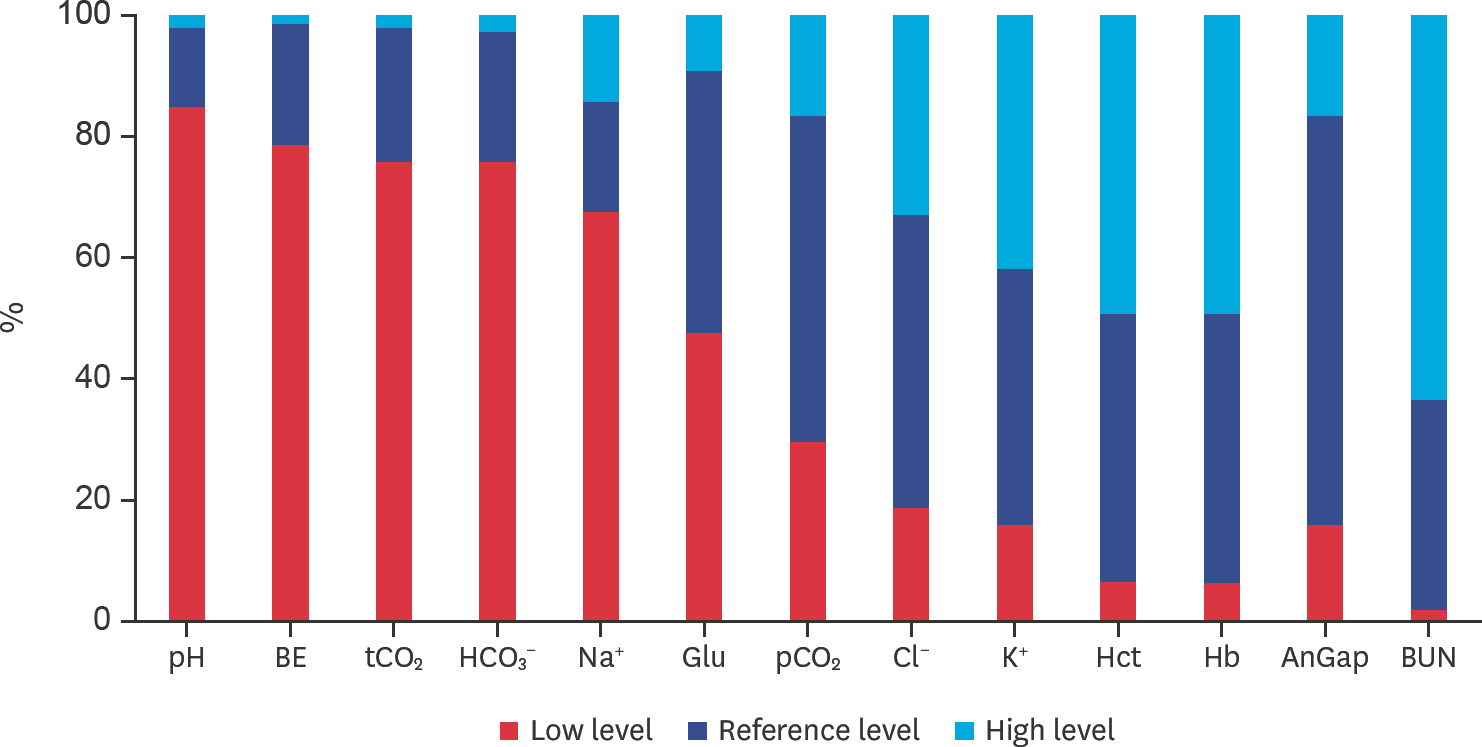1. Omole OO, Nappert G, Naylor JM, Zello GA. Both L- and D-lactate contribute to metabolic acidosis in diarrheic calves. J Nutr. 2001; 131:2128–2131.

2. Gunn AA, Naylor JA, House JK. Diarrhea. Smith BP, editor. (ed.).Large Animal Internal Medicine. 4th ed.pp.p. 340–363. Mosby;St Louis: 2009.
3. Torsein M, Lindberg A, Sandgren CH, Waller KP, Törnquist M, Svensson C. Risk factors for calf mortality in large Swedish dairy herds. Prev Vet Med. 2011; 99:136–147.

4. Bleul U, Götz E. Evaluation of the i-STAT portable point-of-care analyzer for determination of blood gases and acid-base status in newborn calves. J Vet Emerg Crit Care (San Antonio). 2014; 24:519–528.

5. Kim D, Lyoo YS, Lyoo HS, Yoon CK. Etiology and clinical aspects of diarrhea of Korean native calves during the suckling period. Korean J Vet Res. 1990; 30:255–260.
6. Hur TY, Jung YH, Choe CY, Cho YI, Kang SI, Lee HJ, Ki KS, Baek KS, Suh GH. The dairy calf mortality: the causes of calf death during ten years at a large dairy farm in Korea. Korean J Vet Res. 2013; 53:103–108.

7. Trefz FM, Lorch A, Feist M, Sauter-Louis C, Lorenz I. Metabolic acidosis in neonatal calf diarrhea-clinical findings and theoretical assessment of a simple treatment protocol. J Vet Intern Med. 2012; 26:162–170.

8. Lim KG, Kang MI, Kim SK, Nam KW, Park HJ, Park JR, Cho KO, Lee BJ. Identification and characterization of Shiga toxin-producing Escherichia coli isolated from diarrhea in calves. Korean J Vet Res. 2006; 46:135–142.
9. Fayet JC, Overwater J. Prognosis of diarrhoea in the newborn calf: statistical analysis of blood biochemical data. Ann Rech Vet. 1978; 9:55–61.
10. Bardell D, West E, Mark Senior J. Evaluation of a new handheld point-of-care blood gas analyser using 100 equine blood samples. Vet Anaesth Analg. 2017; 44:77–85.

11. Iwabuchi S, Suzuki K, Abe I, Asano R. Comparison of the effects of isotonic and hypertonic sodium bicarbonate solutions on acidemic calves experimentally induced by ammonium chloride administration. J Vet Med Sci. 2003; 65:1369–1371.

12. Sayers RG, Kennedy A, Krump L, Sayers GP, Kennedy E. An observational study using blood gas analysis to assess neonatal calf diarrhea and subsequent recovery with a European Commission-compliant oral electrolyte solution. J Dairy Sci. 2016; 99:4647–4655.

13. Naylor JM. Severity and nature of acidosis in diarrheic calves over and under one week of age. Can Vet J. 1987; 28:168–173.
14. Peiró JR, Borges AS, Gonçalves RC, Mendes LC. Evaluation of a portable clinical analyzer for the determination of blood gas partial pressures, electrolyte concentrations, and hematocrit in venous blood samples collected from cattle, horses, and sheep. Am J Vet Res. 2010; 71:515–521.

15. Izzo MM, Kirkland PD, Mohler VL, Perkins NR, Gunn AA, House JK. Prevalence of major enteric pathogens in Australian dairy calves with diarrhoea. Aust Vet J. 2011; 89:167–173.

16. Constable PD, Walker PG, Morin DE, Foreman JH. Clinical and laboratory assessment of hydration status of neonatal calves with diarrhea. J Am Vet Med Assoc. 1998; 212:991–996.
17. Lee S, Ok S, Kwon H, Kim D. Arterial and venous blood gas, electrolytes, biochemical and hematological values in healthy Korean native calves. J Vet Clin. 2015; 32:499–503.

18. Constable PD, Hinchcliff KW, Done SH, Grünberg W. Veterinary Medicine: A Textbook of the Diseases of Cattle, Horses, Sheep, Pigs, and Goats. 11th ed.pp.p. 384–409. Elsevier;St Louis: 2017.
19. Klein P, Kleinová T, Volek Z, Simů nek J. Effect of
Cryptosporidium parvum infection on the absorptive capacity and paracellular permeability of the small intestine in neonatal calves. Vet Parasitol. 2008; 152:53–59.

20. Naylor JM. A retrospective study of the relationship between clinical signs and severity of acidosis in diarrheic calves. Can Vet J. 1989; 30:577–580.
21. Aldridge BM, Garry FB, Adams R. Neonatal septicemia in calves: 25 cases (1985–1990). J Am Vet Med Assoc. 1993; 203:1324–1329.
22. Abutarbush SM, Petrie L. Treatment of hypernatremia in neonatal calves with diarrhea. Can Vet J. 2007; 48:184–187.
23. Constable PD, Grünberg W. Hyperkalemia in diarrheic calves: implications for diagnosis and treatment. Vet J. 2013; 195:271–272.

24. Hendrix CM, Sirois M. Laboratory Procedures for Veterinary Technicians. 5th ed.p. 416, Kansas: Mosby, St. Louis;2007.
25. Trefz FM, Feist M, Lorenz I. Hypoglycaemia in hospitalised neonatal calves: Prevalence, associated conditions and impact on prognosis. Vet J. 2016; 217:103–108.






 PDF
PDF Citation
Citation Print
Print


 XML Download
XML Download